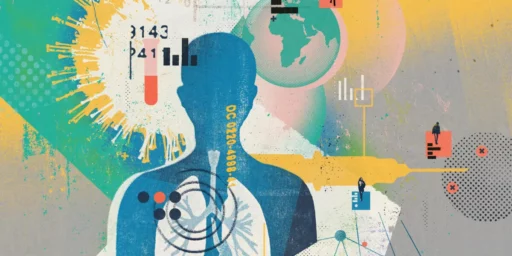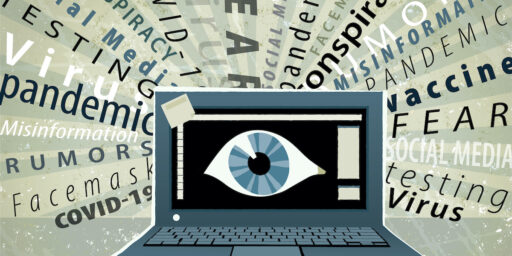A Golden Age for Medicine
Decades of innovation may be coming to fruition.

In a recent NYT Magazine feature, David Wallace-Wellls reports, “Suddenly, It Looks Like We’re in a Golden Age for Medicine.”
Hype springs eternal in medicine, but lately the horizon of new possibility seems almost blindingly bright. “I’ve been running my research lab for almost 30 years,” says Jennifer Doudna, a biochemist at the University of California, Berkeley. “And I can say that throughout that period of time, I’ve just never experienced what we’re seeing over just the last five years.”
A Nobel laureate, Doudna is known primarily for Crispr, the gene-editing Swiss Army knife that has been called “a word processor” for the human genome and that she herself describes as “a technology that literally enables the rewriting of the code of life.” The work for which Doudna shared the Nobel Prize was published more than a decade ago, in 2012, opening up what seemed like an almost limitless horizon for Crispr-powered therapies and cures. But surveying the recent landscape of scientific breakthroughs, she says the last half-decade has been more remarkable still: “I think we’re at an extraordinary time of accelerating discoveries.”
The pandemic has exhausted many Americans of medicine, and it has become common to process the last few years as a saga of defeat and failure. And yet these brutal years — which brought more than a million American deaths and probably 20 million deaths worldwide, and seemed to return even the hypermodern citadels of the wealthy West to something like the experience of premodern plague — might also represent an unprecedented watershed of medical innovation. Beyond Crispr and Covid vaccines, there are countless potential applications of mRNA tools for other diseases; a new frontier for immunotherapy and next-generation cancer treatment; a whole new world of weight-loss drugs; new insights and drug-development pathways to chase with the help of machine learning; and vaccines heralded as game-changing for some of the world’s most intractable infectious diseases.
“It’s stunning,” says the immunologist Barney Graham, the former deputy director of the Vaccine Research Center and a central figure in the development of mRNA vaccines, who has lately been writing about a “new era for vaccinology.” “You cannot imagine what you’re going to see over the next 30 years. The pace of advancement is in an exponential phase right now.”
That people of this stature are this excited is saying something. From my decidedly lay perspective, though, it seems warranted: we’ve essentially invented new ways to invent.
It is sometimes hard to see the silver lining for the cloud, particularly when it’s as dark as the last three years have been. But at the very center of the American Covid experience, amid all the death and suffering and despite the dysfunction that midwifed it into being, sits what would have stood out, in any previous era, as an astonishing biomedical miracle: the coronavirus vaccines. Drug-development timelines in previous history had swallowed whole decades; experts warned not to expect a resolution for years. But the mRNA sequence of the first shot was designed in a weekend, and the finished vaccines arrived within months, an accelerated timeline that saved perhaps several million American lives and tens of millions worldwide — numbers that are probably larger than the cumulative global death toll of the disease.
That this even needs to be pointed out is sad. While it’s easy to second-guess (in some cases, even first-guess) the public health community (the WHO, CDC, and the like) in the way they handled the pandemic, the work of medical scientists was nothing short of spectacular.
The miracle of the vaccines wasn’t just about lives saved from Covid. As the first of their kind to be approved by the Food and Drug Administration, they brought with them a very long list of potential future mRNA applications: H.I.V., tuberculosis, Zika, respiratory syncytial virus (R.S.V.), cancers of various and brutal kinds. And the vaccine innovations stretch beyond mRNA: A “world-changing” vaccine for malaria, which kills 600,000 globally each year, is being rolled out in Ghana and Nigeria, and early trials for next-generation dengue vaccines suggest they may reduce symptomatic infection by 80 percent or more.
That’s remarkable, indeed.
Not every innovation arriving now or soon to market comes from U.S. research or shares the same saga of development. But many of their back stories do rhyme, often stretching back several decades through the time of the Human Genome Project, which was completed in 2003, and the near-concurrent near-doubling of the National Institutes of Health’s budget, which helped unleash what Donna Shalala, President Bill Clinton’s secretary for health and human services, last year called “a golden age of biomedical research.”
That the Human Genome Project was two decades ago is hard to believe. Indeed, it’s hard to believe that it’s been more than ten years since Crispr.
A couple of decades later, it looks like a golden age for new treatments. New trials of breast-cancer drugs have led to survival rates hailed in The Times as “unheard-of,” and a new treatment for postoperative lung-cancer patients may cut mortality by more than half. Another new treatment, for rectal cancer, turned every single member of a small group of cases into cancer-free survivors.
Ozempic and Wegovy have already changed the landscape for obesity in America — a breakthrough that has been described and debated so much in terms of cosmetic benefits and medical moral hazard that it can be easy to forget that obesity is among the largest risk factors for preventable death in the United States. Next-generation alternatives may prove even more effective, and there are signs of huge off-label implications: At least anecdotally, in some patients the drugs appear to curb compulsive behavior across a range of hard-to-treat addictions.
And although the very first person to receive Crispr gene therapy in the United States received it just four years ago, for sickle-cell disease, it has since been rolled out for testing on congenital blindness, heart disease, diabetes, cancer and H.I.V. So far only two applications for such treatments have been submitted to the F.D.A., but all told, some 400 million people worldwide are afflicted by one or more diseases arising from single-gene mutations that would be theoretically simple for Crispr to fix. And when Doudna allows herself to imagine applications a decade or two down the line, the possibilities sound almost intoxicating: offering single-gene protection against high cholesterol and therefore coronary artery disease, for instance, or, in theory, inserting a kind of genetic prophylaxis against Alzheimer’s or dementia.
I’m skeptical of projections more than a year or two out, since they allow the imagination to run wild. But it would indeed be amazing to end these maladies.
Wallace-Wells closes with this:
In January, a much-talked-about paper in Nature suggested that the rate of what the authors called disruptive scientific breakthroughs was steadily declining over time — that, partly as a result of dysfunctional academic pressures, researchers are more narrowly specialized than in the past and often tinkering around the margins of well-understood science.
But when it comes to the arrival of new vaccines and treatments, the opposite story seems more true: whole branches of research, cultivated across decades, finally bearing real fruit. Does this mean we are riding an exponential curve upward toward radical life extension and the total elimination of cancer? No. The advances are more piecemeal and scattered than that, and indeed there are those who believe that progress should be moving faster still.
In the midst of the pandemic, a number of calls for greater acceleration have been issued, some emphasizing the need to reduce costs for drug development, which have doubled every decade since the 1970s, perhaps by redesigning clinical trials or employing what are called human-challenge trials, or by streamlining the drug-approval process. Graham, who is now a senior adviser for global health equity at the Morehouse School of Medicine, emphasizes questions of global distribution and access: Will the new technologies actually get where they are needed most? “The biology and the science that we need is already in place,” he says. “The question now to me is: Can we actually do it?”
In 1987, the economist Robert Solow commented that you could see the computer revolution everywhere but the productivity statistics — that despite intuitions about how fully information technology had transformed all forms of work in America, the step-change hadn’t really made a mark on the country’s economy in any obvious statistical way.
Until a few years ago, perhaps, you might have said the same about billions of dollars spent researching potential H.I.V. vaccines or the decoding of the human genome, which unleashed a venture-capital-like boom-and-bust biotech hype cycle that sputtered out before most Americans had seen any real gains from it. Sometimes these things just take a little time.
Which is pretty much what I was thinking reading the piece. As noted earlier, it seems astonishing that it’s been twenty years (almost exactly) since the Human Genome Project was completed. Both because it doesn’t seem that long ago and because, when the news broke, it was accompanied by wild predictions of the advances that it would herald and it seems like they’ve been much slower in coming than we thought then. But it may well be like the computer revolution: it wasn’t all that revolutionary until suddenly it was.






I think this is little optimistic but it’s not really wrong. We have had to develop the tools that would them let us work on cures. Vaccines were a good start since its a large population and you have a specific target. Cancer in general will be harder as there are so many subgroups. Lung cancer is really many different kinds of cancer as an example. Still lots of reasons for optimism, however there is one thing I dont see mentioned here, cost. I think it was Arrow who talked about our problems if we developed treatments that worked well with high efficacy and lack of problems but they were really expensive. It’s even more difficult if it works for problems affecting lots of people. (Lots of our current very expensive drugs either dont target many people or dont work very well, if at all.) We already spend almost 20% of GDP on medicine.
Steve
I recall reading some years ago an article saying twenty years is a sort of constant. That from initial invention to commercial utility typically takes 20 years. It isn’t just technical development, but development of standards and practices, acceptance by users, growth of a support community, etc. IIRC it cited airplanes and electric motors as examples. I think a case could be made for computers, personal computers, and the internet displaying similar lags.
Wrt/ medicine, as I’ve commented before, we don’t have Dr. Crusher’s Med Lab, but what we have is pretty impressive.
Yes, there is a lot of good news on this front. One of my friends is living with myeloma, a disease that typically had a 6-9 month survival, for four years now due to a monoclonal medication. Dr. Joyner, twenty years does not seem that long ago to me; Magic Johnson was reported to be HIV positive in 1991. Many people with HIV have no detectable virus with contemporary medicines. A malaria vaccine is within reach, and that is fantastic.
Over/under on red states banning it because they claim it’s a satanic communist plot to put cellphones in your blood?
Not according to the GOP. Hell, they want to hang Fauci for the grave sin of helping to save hundreds of thousands of lives.
Sadly, Kevin Drum reports his CAR-T (genetically modified T cells) cancer treatment appears to have not worked. He says it looks like a year or less before he restarts chemo instead of the hoped for cure.
@Stormy Dragon:
As long as I get 6G coverage and a heads up display so I don’t “need” my cell phone, I’m ok with that.
ETA 12 years ago stage 4 colon cancer had a 3 year survival rate of 5%. It’s still hideous at 15%, but I no longer feel like the sole unicorn on the ark.